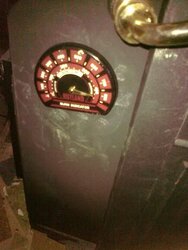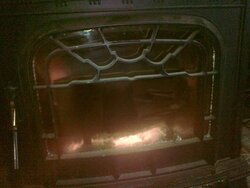Hello All, I have been lurking for sometime but thought I would join the club.
My setup is a Harman Oakwood with a 28 foot evil outside masonry chimney with an 8x8 clay liner. I vent the Oakwood out the top and through one 90 degree bend to the thimble. (Another 90 degree turn to head up the flue) I thought I'd share a couple of tricks I've come up with to keep the Harman stove humming along.
I used to get a smoke smell in the house when I had a full load (reload) in the stove and the afterburner was going. Drove me nuts. It never set off the smoke alarms but it would wake me up at night. Anyway, now when I go to reload the stove, I take a small split of poplar or pine (fast burning) and toss it in with the air controls wide open and the bypass damper open. I let it burn until my thermometer (placed on the lower right corner of the flue collar) is between 500-600. Then I add the full load, wait till it catches (steady flames) and close the bypass damper. Smoke smell gone.
My theory is that near the end of the burn cycle, the flue gasses just aren't hot enough to pull all of the smoke out through the afterburner. Burning that small split seems to "charge" the flue and the combustion pack.
Another tip is to use two thermometers. I have the one previously mentioned and I also place one on the side of the rear housing about half way up. This way I can monitor how the afterburner is doing without walking in and out of the house.
Finally, keep a thick hot coal bed and the difference is amazing.
I admit these stoves take a bit of learning but I really do love the long burn times and the even heat. It really throws the heat! I hope these tips help some fellow Harman owners.
My setup is a Harman Oakwood with a 28 foot evil outside masonry chimney with an 8x8 clay liner. I vent the Oakwood out the top and through one 90 degree bend to the thimble. (Another 90 degree turn to head up the flue) I thought I'd share a couple of tricks I've come up with to keep the Harman stove humming along.
I used to get a smoke smell in the house when I had a full load (reload) in the stove and the afterburner was going. Drove me nuts. It never set off the smoke alarms but it would wake me up at night. Anyway, now when I go to reload the stove, I take a small split of poplar or pine (fast burning) and toss it in with the air controls wide open and the bypass damper open. I let it burn until my thermometer (placed on the lower right corner of the flue collar) is between 500-600. Then I add the full load, wait till it catches (steady flames) and close the bypass damper. Smoke smell gone.
My theory is that near the end of the burn cycle, the flue gasses just aren't hot enough to pull all of the smoke out through the afterburner. Burning that small split seems to "charge" the flue and the combustion pack.
Another tip is to use two thermometers. I have the one previously mentioned and I also place one on the side of the rear housing about half way up. This way I can monitor how the afterburner is doing without walking in and out of the house.
Finally, keep a thick hot coal bed and the difference is amazing.
I admit these stoves take a bit of learning but I really do love the long burn times and the even heat. It really throws the heat! I hope these tips help some fellow Harman owners.



